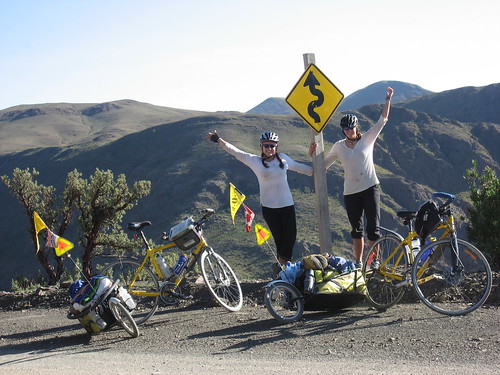Travelling by bike allows you the opportunity to see more than just the pretty side of a country, full of pizza parlours, tour agencies and hotels boasting hot showers and free breakfasts. These touristly areas are always a welcome respite when we get to them....we love the chance to speak our own language, and pizza and cold beer taste delicious after countless meals of pasta and carrots.
But the reason that we love riding is that it lets fully experience a place and its people. Here are some observations from rural Bolivia (and in case anyone with an IDS background is watching, these are not generalizations, simply observatons and I fully understand that my views are tainted by the fact that I'm both female and a foreigner):
- As we rode further away from main roads and highways, the small dots on our maps representing towns began to mean less. Small towns were terribly run down and we would often believe that they were completely abandonned until we'd cross paths with a lone inhabitant at the far end of town. Cemented basketball courts are cracking with weeds and have bent, rusted hoops and many homes have been gutted and are left without roofs or doors. There are no schools, offices or stores. The road through town always passes by the main plaza and church, and although these were in awful disrepair, it was obvious that they were once beautiful and had been buzzing with life. Then along came the highway, and with it came industry and opportunity in the cities and slowly these wonderful little villages emptied and were left to ruin. Its a stark and sad result of modernization in Bolivia.
- I read just today that the poverty rate (not sure by what standard) is around 70% in Bolivia. There is a notable lack of money in many rural places, but it's a different sort of poverty. No one here appears to be going hungry. The ground is fertile and the livestock are fat and plentiful. Homes are made of local materials (mudbricks, stones or salt blocks), and yards are large and generally well kept, often with flower beds out front. Kids are at least educated enough to know to say "Hello, how are you?" to gringos and all that we asked went to school. The people that we've met have all seemed healthy and content despite their lack of money, begging the question of whether income is really the best indicator of poverty. Still, the growing importance of money to the people is obvious. They love to ask the cost of our bikes, our plane tickets to get here, and how much I plan to sell the scarf that I'm knitting for. These questions are definitely uncomfortable ones to deal with and we try our best to avoid them, though they seem to be asked out of genuine interest and not bad intentions.
- From our pictures, I'm sure you've noticed the beauty of the native women here, in their large, bright skirts, colorful backpacks and bowler hats. Most women older than 30 or so dress in their traditional (if imposed by colonialists) dress on a daily basis. Those who work as laborers in the public sector are even issued yellow coverall dresses to work in! Men on the other hand, dress in plain dress pants and shirts, and the only time that we've seen them in their traditional dress is during festivals. As is the case in many cultures, it seems that women in Bolivia are the carriers of culture.
That's all I got....wouldn't McGill be pround of the worldly little graduate they produced (or would they rather I get a real job!?)
-Christine
Saturday, February 24, 2007
Subscribe to:
Post Comments (Atom)

No comments:
Post a Comment